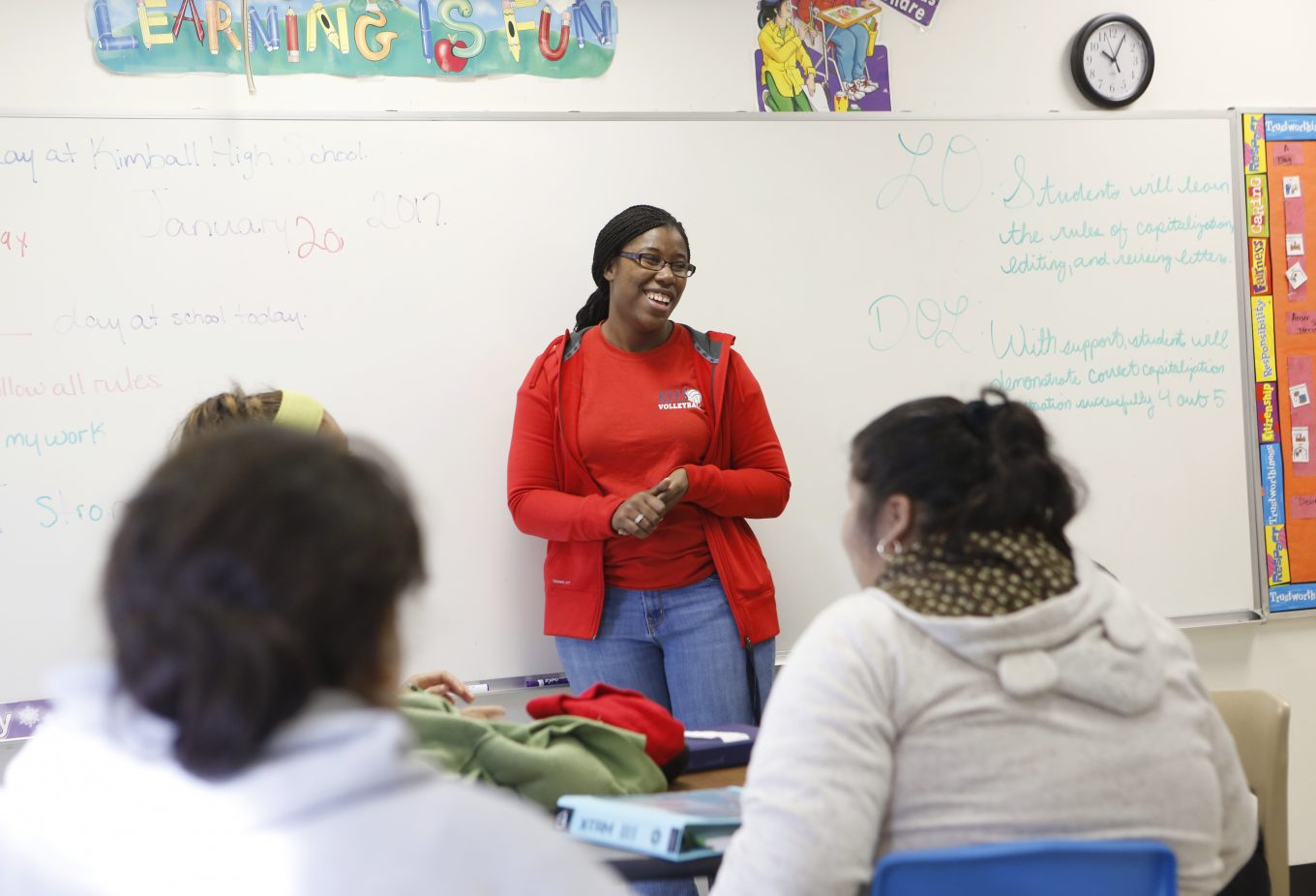 Monica Gray Rhinehart, a 2005 graduate of Kimball High, is now a teacher and coach at the Dallas school. Photo/Lara Solt
Monica Gray Rhinehart, a 2005 graduate of Kimball High, is now a teacher and coach at the Dallas school. Photo/Lara Solt
Educational Resources To Discuss Race In Schools
For decades, education in North Texas was reshaped by white flight. Today, the drivers are diversity and economic flight. This educational toolkit will address those factors as well as the disparities between students of color and their white counterparts.
Intended Audience
Due to the mature subject matter, in some materials, the toolkit is better suited for students in upper elementary through high school.
Learning Outcomes
- Students will be able to describe the effects of integration on individual ethnic groups and the larger community.
- Students will understand the importance of state and federal legislation’s role in the integration of public schools.
- Students will learn about the inequities in public schools that are often associated with race and socio-economic status.
- Students will be able to use media as a tool to engage in deep and meaningful conversations about race, poverty and education.
Lesson Plans and Teaching Resources
The lesson plans and teaching resources provide a historical look at race, poverty and education in America and explore the issues of race and poverty in America’s schools today.
VIDEOS & DISCUSSION QUESTIONS
School’s Out
Reverend James Seawood grew up in the 1950s in Sheridan, Arkansas, and attended an all-black school.
The town’s main employer and landlord was a lumber mill. Following the federal mandate to integrate the public schools, the mill forced its African-American employees and tenants out of town. As the population dwindled, James’ mother became his school’s principal, janitor, and whatever else was needed.
At StoryCorps, he recalls how integration led to African Americans being forced out of his hometown, the human cost of “urban renewal” and the fate of his beloved school.
“School’s Out” online release is presented in partnership with WNYC’s Snap Judgment.
Discussion questions:
- After watching this video, why do you think some whites were afraid or angry about school integration? How did integration affect black students and their families?
- Before integration, black students had to attend all black colleges and universities. Do you think there is still a need for historically black colleges and universities? Why or why not?
Facundo the Great
Ramon “Chunky” Sanchez was raised in a small farming community in southern California in the 1950s. As was common practice at that time, teachers at his local elementary school Anglicized the Mexican-American students’ names. Here, Chunky remembers a new classmate who proved to be the exception to the rule.
Discussion questions:
- Why is pronouncing Facundo’s name correctly important to all of the Mexican-American students? Why is having control over your name powerful?
- What do you think the school wanted to accomplish by changing the Mexican-American students’ names to their English version? What does it mean to “Americanize” something?
- What does a person’s name say about their identity? How do you think changing a student’s name affected the Mexican-American kids’ attitudes about school, their classmates and their chances for success?
1964: “LBJ’s War on Poverty”
President’s Johnson’s “war on poverty” initiative sought not just to alleviate poverty but end it, in this video from American Experience: “1964.” Johnson proposed a vast legislative agenda that would attack the root causes of poverty and provide opportunity for all. Source: PBS LearningMedia.
Discussion questions:
- Why was Johnson’s war on poverty initiative “unprecedented”? In the video, writer Robert Caro says that Johnson was determined not just to “alleviate” poverty but to “end” it. What was different about Johnson’s approach than those who had gone before him?
- Are poverty and race inextricably mixed, as writer Robert Caro says? Was it true in 1964? Is it still true today?
- How are poverty and education connected? Does poverty determine a student’s likelihood for success in school? Why? Or why not?
The Icing on the Cake
Blanca Alvarez and her husband risked crossing the border to immigrate into the United States and then struggled to make ends meet. They hoped to shelter their children from these harsh realities, but Alvarez’s daughter, Connie, reveals how much children can really see of their parents’ lives — and the inspiration they draw from their struggles.
Discussion questions:
- What is cultural awareness? Do you think it’s important for schools to recognize and celebrate different cultures?
- Do you think it’s important to have special programs and services that help immigrant students be successful in school? What components would you include in a program to help immigrant students succeed?
- Do you think parental involvement helps students do better in school? How can parents motivate their children to do well in school?
Generational Poverty | 180 Days: Hartsville
“180 Days: Hartsville” follows the rural town of Hartsville, South Carolina as the town adjusts to new educational standards and maintaining funding with a majority of their students living in poverty. Source: PBS LearningMedia.
Discussion questions:
- What is generational poverty?
- Does society have a lower expectation for people of color? Or children from lower-income families?
- During segregation, the elementary school in the Hartsville video was all white. Today, it educates mostly black students. Why do you think the student body changed? Do you think it’s important for schools to be diverse? Do you think it’s important for students to have teachers and principals that look like them? Why or why not?
‘Maya Angelou: And Still I Rise’ Essay Contest
From a hardscrabble childhood in the Depression-era South Maya Angelou rose to become the poet celebrated for her stirring reading of “On the Pulse of Morning” at President Bill Clinton’s 1993 inauguration. Her poetry, essays and memoirs won many accolades, including the 2013 Literarian Award for Outstanding Service to the American Literary Community from the National Book Foundation. In writing about her own life, she opened eyes to the experiences of African Americans and provided an important window into 20th-century American social history.
The essay contest invites high school students to write an essay interpreting an Angelou poem and describing how it contributes to the understanding of race in the U.S. and the African-American experience. The essays should include a thoughtful proposal for improving race relations based on what the student learned from reading the poem. The top three winners will receive prizes of $150, $100 and $50. Teachers and educators will serve as judges. Here are the contest rules and entry form. Please print the entry form, fill it out, get it signed and submit it as a PDF using this form.
Additional Resources
Articles and reading materials
- Diversity and Inclusion Books and Other Resources: A reading list.
- Local education inequities across U.S. revealed in new Stanford data set. Source: Stanford Data Archive
- Teaching Teachers to Reflect on Race by Tyrone Howard. Source: National Education Association
- Talk About It by Cynthia Kopkowski. Source: National Education Association
- Poverty and high school dropouts by Russell W. Rumberger, PhD. Source: American Psychological Association, May 2013
- Money, Race and Success: How Your School District Compares by Motoko Rich, Amanda Cox and Matthew Bloch. Source: The New York Times
KERA coverage on race and schools
- Texas Trailblazer: Profiles the lives and careers of Erma Johnson Hadley, Kael Alford and Mary Elizabeth (Liz) Cedillo-Pereira, Judge Harold Barefoot Sanders, attorney Louise Raggio and journalist Vivian Castleberry, individuals whose dedication to civil rights and pursuit of justice brought change to Texas and the nation.
- In the early 1970s, Sam Tasby was the lead plaintiff in the Dallas ISD segregation case. In 2003, Tasby talked about how he challenged the district in a KERA-TV program, a co-production with WFAA, called Race & Class in the Schools: An On the Record Special.
- Jonathan Norton Schools Us On How Racial Violence Gets Taught: A story by reporter Jerome Weeks of KERA’s Art&Seek.
- The First Week: A series about the first week of school for students after the Dallas police ambush of July 2016.



